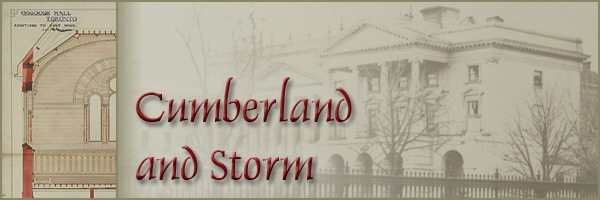
Table of Contents
![Photo: Cabinet Portrait, F. W. Cumberland, [ca. 1867-1871]](pics/ao6350_cumberland_270.jpg)
Frederic William Cumberland was born in 1820 in England. He apprenticed with an architect, the then-accepted method of training, before working for the Civil Architects Department in the British Admiralty Royal Dockyards.
An ambitious man searching for better opportunities, he immigrated to Canada in 1847. Good references, family connections, a rapidly growing province in need of public buildings, and substantial talents as an architect and businessman contributed to his rapid success in his new home.
Cabinet Portrait, F. W. Cumberland, [ca. 1867-1871]
Black and white negative
Cumberland family fonds
Reference Code: F 1132-5-0-2
Archives of Ontario, AO6350
William George Storm was born in England in 1826 and immigrated to Canada as a child. He apprenticed with his father, a respected master builder and contractor, and then with successful Toronto architect William Thomas.
![Watercolour: St. James Cathedral; watercolour persective, looking north, [ca. 1858-ca. 1860]](pics/5482_st_james_270.jpg) |
William became Cumberland’s assistant at the end of the1840s, when the latter was working on St. James Cathedral. He was made partner in the firm in 1852.
Click to see a larger image (109K) |
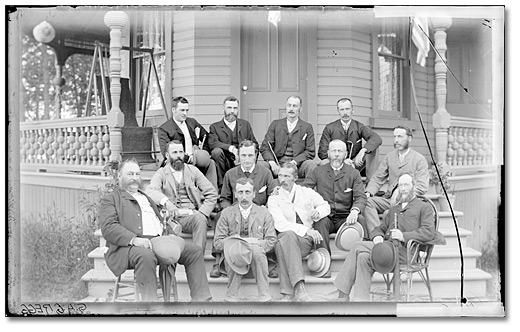
Click to see a larger image (220K)
Members of the Toronto Architectural Guild meeting at the summer home of Edmund Burke, August 1888
Black and White Negative
Reference Code: Acc. #12983, S-17199
Archives of Ontario, I0027943
In the photograph above, Storm is the first man in the front row. Edmund Burke, sitting above Storm, took over his practice at his death and inherited the Osgoode Hall drawings.
Cumberland and Storm complemented one another. Cumberland was the manager of the firm, the planner and the organizer. He was the one who met with clients and he liked to supervise projects.
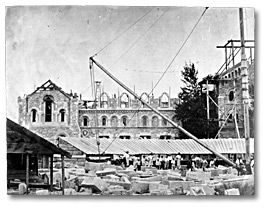 Click to see a larger image (89K) |
There are no known photographs of the 1850s construction campaign at Osgoode Hall, but the site of University College, a concurrent project of Cumberland & Storm, was probably not very different. Cumberland would likely have been a familiar sight on the property, supervising the progress of the work.
|
Storm was the detail person; he was thorough and he benefited from the practical building experience garnered under his father’s supervision. Storm was also the artist of the two; many of the firm’s admirable drawings are from his hand. An example of his artistic skill can be seen below.
![Drawing: Osgood Hall, library; interior perspective, [ca. 1857-1859]](pics/5480_osgoode_520.jpg)
Osgoode Hall, library; interior perspective, [ca. 1857-1859]
Cumberland and Storm, Frederic William Cumberland, William G. Storm
Drawing
J. C. B and E. C. Horwood Collection
Reference Code: C 11-102-0-6,(747)2
Archives of Ontario, I0005480
The creative contribution of each man to the partnership is the subject of debate. If Storm wielded the pen and brushes, was he also the designer for this prolific firm? It is generally agreed that Cumberland was the one who provided the general conception of the designs while Storm dealt with the design details.
![Atrium keystone, [ca. 1855-1859] - 1](pics/c11_101_751_12_detail_250.jpg)
These keystones from the building’s atrium, represent the arts and trades, and embody the essence of the partnership – the artistry of Storm and the reasoning of Cumberland.
Cumberland firmly believed that science, art and commerce were interconnected and were the foundation, the “keystones” of the Victorian world.
Click to see a larger image (101K)
Atrium keystone, [ca. 1855-1859]
Cumberland and Storm
J. C. B. and E. C. Horwood Collection
Reference Code: C 11-101(751)12
Archives of Ontario
![Atrium keystone, [ca. 1855-1859] - 2](pics/c11_101_751_14_detail_250.jpg)
Atrium keystone, [ca. 1855-1859]
Cumberland and Storm
J. C. B. and E. C. Horwood Collection
Reference Code: C 11-101(751)14
Archives of Ontario
![Atrium keystone, [ca. 1855-1859] - 4](pics/c11_101_751_detail_270.jpg)
Atrium keystone, [ca. 1855-1859]
Cumberland and Storm
J. C. B. and E. C. Horwood Collection
Reference Code: C 11-101(751)6
Archives of Ontario
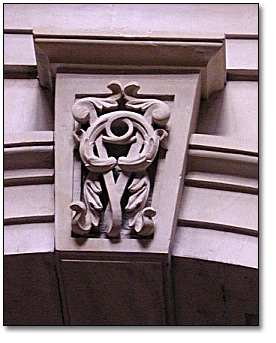
Keystone, Rotunda, Osgoode Hall
The Law Society of Upper Canada
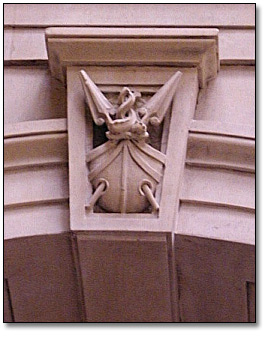
Keystone, Rotunda, Osgoode Hall
The Law Society of Upper Canada
When it comes to Osgoode Hall, one author suggests that Storm’s involvement may have been more substantial. A letter by one of Cumberland’s sons to the Toronto World of February 26, 1886, a few years after Cumberland’s death, stated that University College, designed in 1856, was his father’s last design.
What we know is that while Cumberland & Storm continued to appear as a firm in directories until at least 1866, Cumberland had long turned to other interests. Foremost among those was his involvement with the Northern Railway Company, first as Chief Engineer in 1852, and eventually as its General Manager starting in 1859.
Despite the apparent backseat he took in the designs of the firm, Storm was not without architectural skill. After the end of the partnership, Storm worked mostly on his own, first mainly on additions and changes to existing buildings, then undertaking full-fledged, praiseworthy design projects. Storm became the first President of the Ontario Association of Architects in 1889.
|
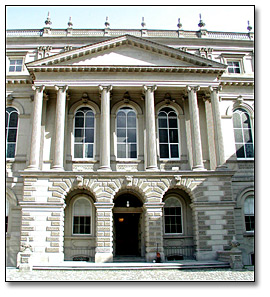 Osgoode Hall façade |